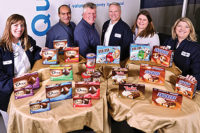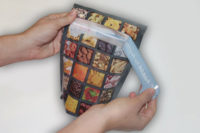Today’s consumers are increasingly interested in health, conservation and convenience, according to Euromonitor International’s March 2015 report on dairy packaging in the United States. These demands underlie retailers’ requests for thinner packaging, easy recycling and individual servings of dairy products, and the resulting changes in the way dairy companies process and package their products.
Processing and packaging technology suppliers are accommodating the accompanying material and equipment requirements with innovations such as those seen in September at Pack Expo Las Vegas, where exhibitors showcased a wide range of solutions to address sustainability, convenience and portion control. The show also highlighted processing and packaging equipment that encourages greater flexibility and efficiency in production to facilitate these transitions.
Rigid formats evolve
On the sustainability front, there is good news for dairy manufacturers. According to the Carton Council of North America, “45% of U.S. households have access to carton recycling, meaning that liquid cartons are also sustainable packs.”1
However, the impact that rigid packaging has on the environment is still a concern for the dairy industry. In response to rising consumer interest in environmentally responsible packaging, companies are making efforts to reduce material, specifically by thinning the walls of rigid containers. Similar to the changes we’ve seen over the past few years in water bottle packaging, milk producers are looking to package products in thinner containers to limit the ecological footprint left behind.
The CrystalView system that was introduced at Pack Expo Las Vegas by Agr International Inc., Butler, Pa., allows PET (polyethylene terephthalate) bottles to be produced with consistent crystalline structure while maintaining a desired thickness. This process yields a stronger, better-performing container and enables users to produce lightweight bottles that reduce ecological harm without compromising the structural integrity of the packaging.
Striving for health
Health-conscious dairy consumers are seeking products that allow them to maintain active, on-the-go lifestyles. According to the 2015 Global Packaging Report from PMMI, this is good news for the dairy sector. The report states that “a growing health consciousness among consumers throughout the region will see rising volume sales of packaging in healthy food and beverages such as milk and dairy products.”
However, even among expectations of rising sales, dairy companies aren’t letting the pace of innovation stagnate. Increasingly, these companies are packaging their products in a variety of sizes, including smaller, single servings to appeal to active, health conscious consumers.
Nonrefrigerated product demand
Increasingly, aseptic packaging is taking center stage as more and more retailers are seeking nonrefrigerated packaging for dairy products as a suitable answer to the changing lifestyles of consumers and their interest in limiting their environmental footprints. Euromonitor’s findings back this point, stating that, “retail volume sales of long-life/UHT milk have been performing better than those of chilled milk as consumers have busier lifestyles.”
Products that do not need to be stored in refrigeration cost less and last longer. Packaging that aids the shelf-life of a product, like aseptic packaging, is becoming more and more in demand as dairy moves from refrigeration to store shelves.
Tetra Pak, Denton, Texas, has Tetra Brik Aseptic an aseptic packaging solution suitable for dairy products that helps increase the shelf-life of nonrefrigerated dairy without the need of additives or preservatives.
The demand for nonrefrigerated dairy products has also increased variations in packaging materials, like PET. Euromonitor found nonrefrigerated dairy products such as flavored milk drinks contributed to a 6% volume growth for PET bottles in 2014. Some PET bottles don’t require refrigeration during distribution and that increases the consumer convenience factor.
Technological innovations
The dairy industry is facing pressures to guarantee safe and effective production, and dairy producers are using technological advancements in processing and packaging as preventative measures on their lines. We see this trend unfolding in maintenance and service areas, especially in the addition of sensors that allow managers to detect issues on the line before they disrupt production. Managers are then able to keep spare equipment on site in order to limit the wait in receiving new parts should any machinery experience a breakdown or malfunction.
Changing trends to dairy processing and packaging have had a major impact on the technological innovations in the supply chain. Consumers’ shifting attention to sustainability, convenience and healthy lifestyles have placed new demands on manufacturers — and driven the development of environmentally responsible, on-the-go and carefully portioned packaging.
1 According to the Carton Council of North America, 55% of U.S. households have access to carton recycling.




